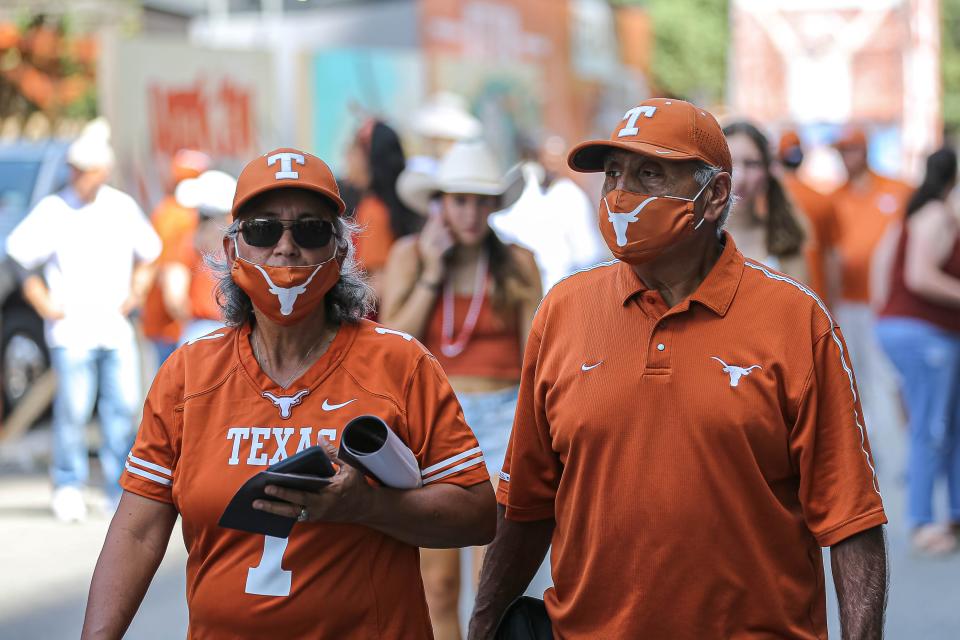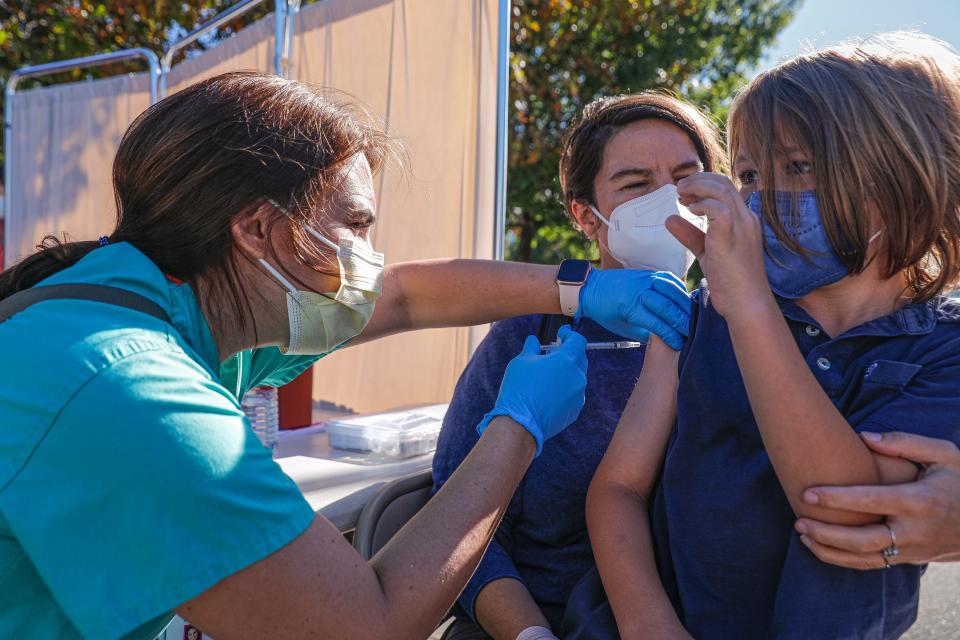COVID-19 cases steady in Austin as new boosters roll out; other epidemics being watched
- Oops!Something went wrong.Please try again later.
The federal Centers for Disease Control and Prevention has approved the updated COVID-19 boosters that target the spike protein of both the original COVID-19 strain and the omicron BA.4 and BA.5 strains, which are currently circulating.
The action Thursday came a day after the FDA gave authorization for the updated boosters and removed the authorization of the prior vaccines as boosters.
What's happening with COVID-19 in the Austin area?
Locally, COVID-19 levels have remained steady in the past three weeks. Travis and Williamson counties have a low level of coronavirus spread, according to the CDC. Hays, Caldwell and Bastrop counties have a medium level of spread. Those levels get reevaluated every Thursday.
The difference in the local counties is their transmission rates. Counties must have fewer than 200 cases per 100,000 people to be considered at a low level of spread. Travis County's rate was up slightly this week to 159.9 compared with 155.89 the week before. Williamson County's rate was 82.3 last week and has not been updated by the CDC or the county.
Hays County's transmission rate rose to 260.22, up from 216.78. Caldwell County rose to 279.41 from 251.92 last week. Bastrop County's level was almost the same as the week before at 222.04 instead of 223.17. As soon as the transmission rates drop below 200, those counties will reach a low level.
With a low level of spread, CDC guidelines recommend that people up to date with COVID-19 vaccines and boosters who are not at risk for severe disease don't need to take precautions such as masking. Those at higher risk or the unvaccinated also could decide not to take precautions.
At the medium level of community spread, CDC guidelines say that precautions are optional for people who are up to date with their vaccinations, including boosters, but recommend that they wear a mask when social distancing is not possible. Under the medium level, people who are at higher risk or who are not vaccinated or not up to date in their vaccine doses are advised to use precautions while gathering, dining and shopping.
The CDC also looks at hospital capacity when considering these rates. All five local counties have 3% of their hospital beds occupied by people with COVID-19 and have between 7.9 and 5.1 of new hospitalizations with COVID-19 per 100,000 people. If either of those numbers rose above 10, the counties would be at least at a medium level of spread even if the transmission rates were below 200.

Austin-area hospitalizations for COVID-19 still happening
"It was the summer of getting back to normal as much as we could," said Dr. Brian Metzger, medical director of infectious diseases at St. David's HealthCare, when he compares this summer with the previous two summers, which had the first wave of COVID-19 and the delta wave.
Currently, in the Austin area, there are 101 people hospitalized with COVID-19, including 14 in an intensive care unit and four on ventilators, but Metzger said about 40% of the patients in the hospital with COVID-19 this summer have been there for other reasons and happened to test positive for the virus.
Even though the omicron variant of the coronavirus, particularly in its current BA.4 and BA.5 versions, has been less virulent than previous strains, Metzger said, "it still has a mortality rate to it; it still has a rate of severe disease to it. Even now, it's safe to say it's still higher (mortality and severe disease) than influenza, even with a relatively less severe strain."
Checking virus levels: Monkeypox cases rise in Travis County; more than 100 confirmed
When is the new COVID-19 booster available in Austin?
The federal government began shipping out the updated boosters Thursday and will be continuing to ship them to pharmacies, health departments, hospitals and clinics throughout the country.
Texas has been allotted 900,000 doses. About 700,000 will go to health care providers. The other 200,000 doses will be available at H-E-B, Walgreens, CVS and Walmart pharmacies.
Austin Public Health, Austin Regional Clinic and CVS have indicated they have put in their booster orders and were waiting to receive them.
CVS expected to open up appointments for boosters within days once it received the boosters.
Austin Regional Clinic expects to be vaccinating people with the new booster in the next few weeks once it receives the boosters and has all the systems in place to make sure the right people receive it.
Understanding the new boosters:FDA authorizes new COVID-19 booster shot to target omicron variant. What you need to know
Who can get the new COVID-19 booster?
The Pfizer form of the booster can be given to anyone 12 and older who has completed the primary series of a Pfizer, Moderna, Janssen or Novavax vaccine. The Moderna updated booster can be given to people 18 and older who have completed the primary series of one of those four COVID-19 vaccines.
You have to wait two months after your last COVID-19 vaccination before receiving the updated booster.
The original form of the vaccine will no longer be given as a booster dose, and you cannot use the booster as a vaccine in the primary series (either one shot for Janssen or two shots for the other COVID-19 vaccines).
The vials look very similar to the original form but have the words "bivalent booster" on them.

What about the COVID-19 boosters for children 11 and younger?
The FDA and CDC, in their advisory committee meetings, indicated that boosters for the younger children will be coming within months, probably starting with the 5- to 11-year-olds and then the 6-month-old to 4-year-old age range.
If I've had COVID-19 recently, do I need to wait to get boosted?
No. You just have to have no longer be symptomatic.
It's still a good idea to get an updated booster, Metzger said, even if you've had COVID-19 because "not everyone gets the same level of these neutralizing antibodies through infection" that the booster delivers.
"This is kicking off an era where we're going to be able to in the near future every summer decide what strain will be the predominate strain in the coming winter and design the vaccine to better target it," Metzger said.
BA.4 and BA.5 still cause about 90% of the COVID-19 infections, and we have not seen a new strain popping up yet, Metzger said. The new boosters will be targeting what is circulating now.
COVID-19 immunity wanes over time, he noted. "The higher the antibody level, the lower the incident of infection and the lower incident of severe disease and death," he said.
Stacking epidemics now
In addition to COVID-19, Austin Public Health is tracking monkeypox cases, which continue to rise. As of Thursday, Travis County had 134 cases, up from 118 last week. Williamson County had nine confirmed and four presumed cases. Hays County had 11 cases. The area's public health region has 165 cases. Texas now has 1,598 cases, including nine in children and 41 in women.
On Tuesday, Texas recorded its first death from monkeypox, but that was in a person in Harris County who was severely immune-compromised. It's not clear if monkeypox played a role in the death.
Metzger said only a few monkeypox patients locally have had to be hospitalized and that has been to control pain. "The lesions can be very painful," Metzger said. "It's not an infection you want to have. The rash can last for three or four weeks. You can be infectious for that long and have to adjust your life and isolate."
Monkeypox spread:Texas sees first monkeypox-related death as disease continues spreading
What about polio?
While there have been polio cases in New York, Austin has not recorded any polio yet, though it is a concern, Metzger said.
During the COVID-19 pandemic, many children didn't get the normal childhood vaccinations. "There's going to be a large, susceptible population to childhood disease like polio until that gap can be closed," he said. He believes we might see cases of measles again, too.
Get ready for flu season
Flu season is difficult to predict, Metzger said, but "we're due for a little bit of a larger season," he said.
The flu didn't circulate at a wide level the past two years, which means we have a higher number of people who don't have the immunity to it and will be more susceptible to the flu, he said.
Doctors recommend getting the flu shot before Halloween. You can get your flu shot and your COVID-19 booster at the same time.
This article originally appeared on Austin American-Statesman: COVID cases remain steady in Austin as new boosters soon will arrive

